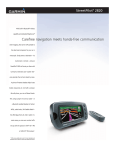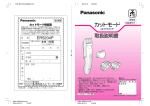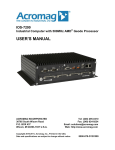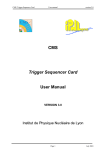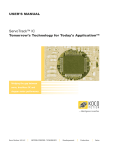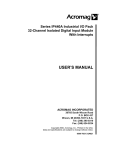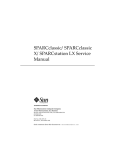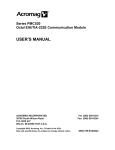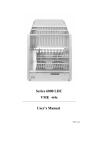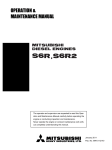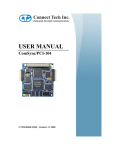Download APCe8650 Industrial I/O Pack User`s Manual
Transcript
Series AcPC8625A Industrial I/O Pack CompactPCI Bus Non-Intelligent Carrier Board USER’S MANUAL ACROMAG INCORPORATED 30765 South Wixom Road P.O. BOX 437 Wixom, MI 48393-7037 U.S.A. Tel: (248) 295-0310 Fax: (248) 624-9234 Copyright 2011, Acromag, Inc., Printed in the USA. Data and specifications are subject to change without notice. 8500-915 B12F003 INDUSTRIAL I/O PACK SERIES AcPC8625A CompactPCI BUS CARRIER BOARD Contents 1. GENERAL INFORMATION ......................................................................................................................... 5 KEY AcPC8625A / 8635A FEATURES ........................................................................................................ 5 SIGNAL INTERFACE PRODUCTS ................................................................................................................ 7 Cables ................................................................................................................................................. 7 Termination Panel: ............................................................................................................................. 7 CompactPCI Transition Module: ........................................................................................................ 7 IP MODULE Windows Software.......................................................................................................... 8 IP MODULE VxWORKS SOFTWARE ..................................................................................................... 8 IP MODULE LINUX SOFTWARE ........................................................................................................... 8 2. PREPARATION FOR USE ........................................................................................................................... 9 UNPACKING AND INSPECTION ................................................................................................................ 9 CARD CAGE CONSIDERATIONS ........................................................................................................... 9 Board Configuration ........................................................................................................................... 9 Interrupt Configuration .................................................................................................................... 10 CONNECTORS ........................................................................................................................................ 10 Carrier Field I/O Connectors Model AcPC8625A .............................................................................. 10 IP Field I/O Connectors (IP modules A through D) ........................................................................... 10 IP Logic Interface Connectors (IP modules A through D) ................................................................. 11 CompactPCI Bus Connections for J1 ................................................................................................. 12 CompactPCI I/O Signals Connections for J4 ..................................................................................... 13 CompactPCI I/O Signals Connections for J5 ..................................................................................... 13 3. DATA TRANSFER TIMING ....................................................................................................................... 14 FIELD GROUNDING CONSIDERATIONS .................................................................................................. 15 PROGRAMMING INFORMATION ........................................................................................................... 16 CompactPCI Configuration Address Space ....................................................................................... 16 Configuration Transactions .............................................................................................................. 16 Configuration Registers .................................................................................................................... 17 Memory Map.................................................................................................................................... 18 Carrier Status/Control Register - (Read/Write, PCIBar2 + 00H) ....................................................... 20 IP Interrupt Pending Register - (Read, PCIBar2 + 02H)..................................................................... 21 Clock Control Register - (Read/Write, PCIBar2 + 018H) ................................................................... 22 IP Module Interrupt Space - (Read Only) ......................................................................................... 22 IP Module ID Space- (Read Only) ..................................................................................................... 22 IP Module I/O Space - (Read/Write) ................................................................................................ 23 Acromag, Inc. Tel: 248-295-0310 -2- www.acromag.com INDUSTRIAL I/O PACK SERIES AcPC8625A CompactPCI BUS CARRIER BOARD IP Module Memory Space - (Read/Write) ........................................................................................ 23 GENERATING INTERRUPTS .................................................................................................................... 23 Sequence of Events for Processing an Interrupt .............................................................................. 23 4. 5. 6. THEORY OF OPERATION ........................................................................................................................ 25 CARRIER BOARD OVERVIEW .................................................................................................................. 25 PCI Bus Interface.................................................................................................................................... 25 Carrier Board Registers.......................................................................................................................... 25 IP Logic Interface ................................................................................................................................... 26 Carrier Board Clock Circuitry ................................................................................................................. 26 PCI Interrupter ....................................................................................................................................... 26 Power Failure Monitor .......................................................................................................................... 27 Power-On Reset ..................................................................................................................................... 27 Power Supply Fuses ............................................................................................................................... 27 Power Supply Filters .............................................................................................................................. 27 Software Compatibility with the APC8625 ............................................................................................ 28 SERVICE AND REPAIR ............................................................................................................................. 29 SERVICE AND REPAIR ASSISTANCE ........................................................................................................ 29 PRELIMINARY SERVICE PROCEDURE ................................................................................................ 29 WHERE TO GET HELP ............................................................................................................................. 29 SPECIFICATIONS ..................................................................................................................................... 30 PHYSICAL................................................................................................................................................ 30 Connectors ....................................................................................................................................... 30 Power ............................................................................................................................................... 30 Fuses ................................................................................................................................................. 30 CompactPCI BUS COMPLIANCE ........................................................................................................ 31 INDUSTRIAL I/O PACK COMPLIANCE ................................................................................................ 31 7. ENVIRONMENTAL .................................................................................................................................. 32 APPENDIX............................................................................................................................................... 33 AcPC8625A Cables, Termination Panels and Transition Modules......................................................... 33 CABLE: MODEL 5028-187 (SCSI-2 to Flat Ribbon, Shielded)............................................................ 33 TERMINATION PANEL: MODEL 5025-552........................................................................................ 33 CompactPCI TRANSITION MODULE: MODEL TRANS-C200............................................................... 34 DRAWINGS............................................................................................................................................. 35 Notes: .................................................................................................................................................... 39 Acromag, Inc. Tel: 248-295-0310 -3- www.acromag.com INDUSTRIAL I/O PACK SERIES AcPC8625A CompactPCI BUS CARRIER BOARD The information contained in this manual is subject to change without notice. Acromag, Inc. makes no warranty of any kind with regard to this material, including, but not limited to, the implied warranties of merchantability and fitness for a particular purpose. Further, Acromag, Inc. assumes no responsibility for any errors that may appear in this manual and makes no commitment to update, or keep current, the information contained in this manual. No part of this manual may be copied or reproduced in any form, without the prior written consent of Acromag, Inc. IMPORTANT SAFETY CONSIDERATIONS It is very important for the user to consider the possible adverse effects of power, wiring, component, sensor, or software failures in designing any type of control or monitoring system. This is especially important where economic property loss or human life is involved. It is important that the user employ satisfactory overall system design. It is agreed between the Buyer and Acromag, that this is the Buyer's responsibility. Acromag, Inc. Tel: 248-295-0310 -4- www.acromag.com INDUSTRIAL I/O PACK SERIES AcPC8625A CompactPCI BUS CARRIER BOARD 1. GENERAL INFORMATION The AcPC8625A card is a personal computer Compact Peripheral Component Interconnect (CompactPCI) bus card and a carrier for the Industrial I/O Pack (IP) mezzanine board field I/O modules. The carrier board provides a modular approach to system assembly, since each carrier can be populated with any combination of analog input/output, digital input/output, communication, etc. IP modules. Thus, the user can create a board which is customized to the application. This saves money and space - a single carrier board populated with IP modules may replace several dedicated function CompactPCI bus boards. The AcPC8625A non-intelligent carrier board provides impressive functionality at low cost. This model is available in the standard CompactPCI bus 6U size with support for up to four IP modules. Model AcPC8625A AcPC8625AE CompactPCI Board Size 6U 6U Supported IP Slots 4(A,B,C,D) 4(A,B,C,D) Operating Temperature Range 0 to +70 C -40 to +85 C KEY AcPC8625A / 8635A FEATURES PCI Specification Version 2.2 and PICMG 2.1, R2.0 Compliant Slave Carrier Provides a CompactPCI bus interface to control and communicate with industry standard IP modules. Interface for Four IP Modules - Provides an electrical and mechanical interface for up to four industry standard IP modules. IP Modules are available from Acromag and other vendors in a wide variety of Input/Output configurations to meet the needs of varied applications. Plug-And-Play CompactPCI bus Carrier - The carrier card contains standard CompactPCI bus configuration memory. Upon power-up the system autoconfiguration process assigns the carrier’s base address in memory space. Plug-And-Play Interrupt Support - The personal computer system software will allocate one interrupt line to the carrier. The carrier’s interrupt pending register can be used to quickly identify IP module pending interrupts. Supports Two Interrupt Channels per IP - Up to two interrupt requests are supported for each IP. Additional registers are associated with each interrupt request for control and status monitoring. Full IP Register Access - Makes maximum use of logically organized programmable registers on the carrier boards to provide for easy configuration and control of IP modules. Supports accesses to IP memory, input/output, interrupt, and ID ROM data spaces. Support for memory space is jumper selectable. Acromag, Inc. Tel: 248-295-0310 -5- www.acromag.com INDUSTRIAL I/O PACK SERIES AcPC8625A CompactPCI BUS CARRIER BOARD IP Module Access Time Out - Allows access to empty IP slots without system failure. If the IP module accessed does not respond within 32u seconds the bus access is terminated without system failure. This allows each IP slot to be probed to determine if an IP is installed. A control register bit will be set and/or issue of an interrupt request will be made to indicate IP module time out access has occurred. IP Module Selectable Clock - Allows for each IP module to be individually configured with an 8MHz or 32MHz clock. LED Indicators Simplify Debugging - Front panel LED's are dedicated to each IP module to give a visual indication of successful IP accesses. Rear Backplane I/O Access - Rear backplane connectors P4 and P5 provide access to field I/O signals mapped per the IP on CompactPCI Specification (PICMG 2.4, R1.0). A transition module (Acromag Model TRANS-C200) routes the field I/O signals from P4 and P5 to the rear of the cage system with separate SCSI-2 connectors for each IP module. All SCSI-2 connectors can be connected with a standard SCSI-2 cable from the transition module without interference from boards in adjacent slots. Spring latch hardware on the transition module provides for excellent connection integrity and easy cable removal. Supervisory Circuit for Reset Generation - A microprocessor supervisor circuit provides power-on, power-off, and low power detection reset signals to the IP modules per the IP specification. Individually Filtered Power - Filtered +5V, +12V, and -12V DC power is provided to the IP modules via passive filters present on each supply line serving each IP. This provides optimum filtering and isolation between the IP modules and the carrier board and allows analog signals to be accurately measured or reproduced on IP modules without signal degradation from the carrier board logic signals. Individually Fused Power - Fused +5V, +12V, and -12V DC power is provided. A fuse is present on each supply line serving each IP module. ESD Strip on AcPC8625A - The AcPC8625A board has been designed to provide electrostatic discharge (ESD) capability by using an ESD strip on the board per ANSI/VITA 1.1-1997 and IEEE1101.10. Injector/Ejector Handle - The AcPC8625A uses a modern injector/ejector handle, which pushes the board into the rack during installation and has a positive self-locking mechanism so it cannot be unlocked accidentally. This handle is fully IEEE 1101.10 compliant and is needed to give leverage to install and remove the board. EMC Front Panel - The AcPC8625A uses the preferred EMC front panel per IEEE 1101.10 specification. Universal Signaling Voltage - The AcPC8625A implements 3.3 Volt signaling and is 5 Volt tolerant Acromag, Inc. Tel: 248-295-0310 -6- www.acromag.com INDUSTRIAL I/O PACK SERIES AcPC8625A CompactPCI BUS CARRIER BOARD Slave Module- All read and write accesses are implemented as either a 32-bit, 16-bit or 8-bit single data transfer. Immediate Disconnect on Read - The PCI bus will immediately disconnect after a read. The read data is then stored in a read FIFO. Data in the read FIFO is then accessed by the PCI bus when the read cycle is retried. This allows the PCI bus to be free for other system operations while the read data is moved to the read FIFO. Interrupt Support - PCI bus INTA# interrupt request is supported. All IP module interrupts are mapped to INTA#. Carrier board software programmable registers are utilized as interrupt request control and status monitors. SIGNAL INTERFACE PRODUCTS (See Appendix for more information on compatible products) This IP carrier board will mate directly to all industry standard IP modules. Acromag provides the following interface products (all connections to field signals are made through the carrier board and transition module which passes them to the individual IP modules): Cables Model 5028-187 (SCSI-2 to Flat Ribbon Cable, Shielded): A round 50 conductor shielded cable with a male SCSI-2 connector at one end and a flat female ribbon connector at the other end. The cable is used for connecting AcPC8525A with the TRANS-C200, or other compatible carrier boards, to Model 5025-552 termination panels. Termination Panel: Model 5025-552: DIN-rail mountable panel provides 50 screw terminals for universal field I/O termination. Connects to Acromag AcPC8525A with the TRANSC200, or other compatible carrier boards, via SCSI-2 to Flat Ribbon Cable, Shielded (Model 5028-187). CompactPCI Transition Module: Model TRANS-C200: This module plugs into the rear backplane directly behind the carrier board. The field I/O connections are made through the backplane to J4 and J5 connectors of the carrier board and then routed to four SCSI-2 connectors on the transition module (marked IP module slots “A through D”) for rear exit from the card cage. It is available for use in CompactPCI bus card cages which provide rear exit for I/O connections via transition modules (transition modules can only be used in card cages specifically designed for them). It is a double-height (6U), single-slot module with front panel hardware adhering to the CompactPCI Specification (PICMG 2.0, R2.1-1997) and IEEE Standard (1101.11-1998), with a printed circuit board depth of 80mm, which is a standard transition module depth. The transition module connects to Acromag Termination Panel (Model 5025-552) using SCSI-2 to Flat Ribbon Cable, Shielded (Model 5028-187) to the rear of the card cage, and to AcPC8525A boards within the card cage. Acromag, Inc. Tel: 248-295-0310 -7- www.acromag.com INDUSTRIAL I/O PACK SERIES AcPC8625A CompactPCI BUS CARRIER BOARD IP MODULE Windows Software Acromag provides software products (sold separately) to facilitate the development of Windows applications interfacing with Industry Pack modules installed on Acromag PCI carrier cards, PCI Express carrier cards and CompactPCI carrier cards. This software (models IPSW-API-WIN32 and IPSW-API-WIN64) consists of low-level drivers and Dynamic Link Libraries (DLLs) that are compatible with a number of programming environments. The DLL functions provide a high-level interface to boards eliminating the need to perform low-level reads/writes of registers, and the writing of interrupt handlers. IP MODULE VxWORKS SOFTWARE Acromag provides a software product (sold separately) consisting of board VxWorks software. This software (Model IPSW-API-VXW) is composed of VxWorks (real time operating system) libraries for all Acromag IP modules and Carriers, PCI I/O Cards, and CompactPCI I/O Cards. The software is implemented as a library of “C” functions which link with existing user code to make possible simple control of all Acromag PCI boards. IP MODULE LINUX SOFTWARE Acromag provides a software product (available on website) consisting of board Linux® software. This software (Model IPSW-API-LINUX) is composed of Linux® libraries for all Acromag IP modules and carriers including the AVME9670 and AVME9660/9630. The software supports X86 PCI bus only and is implemented as library of “C” functions. These functions link with existing user code to make possible simple control of all Acromag PCI boards. Acromag, Inc. Tel: 248-295-0310 -8- www.acromag.com INDUSTRIAL I/O PACK SERIES AcPC8625A CompactPCI BUS CARRIER BOARD 2. PREPARATION FOR USE UNPACKING AND INSPECTION Upon receipt of this product, inspect the shipping carton for evidence of mishandling during transit. If the shipping carton is badly damaged or water stained, request that the carrier's agent be present when the carton is opened. If the carrier's agent is absent when the carton is opened and the contents of the carton are damaged, keep the carton and packing material for the agent's inspection. For repairs to a product damaged in shipment, refer to the Acromag Service Policy to obtain return instructions. It is suggested that salvageable shipping cartons and packing material be saved for future use in the event the product must be shipped. This board is physically protected with packing material and electrically protected with an anti static bag during shipment. It is recommended that the board be visually inspected for evidence of mishandling prior to applying power. The board utilizes static sensitive components and should only be handled at a static-safe workstation. CARD CAGE CONSIDERATIONS Refer to the specifications for loading and power requirements. Be sure that the system power supplies are able to accommodate the power requirements of the carrier board, plus the installed IP modules, within the voltage tolerances specified. IMPORTANT: Adequate air circulation must be provided to prevent a temperature rise above the maximum operating temperature. The lack of air circulation within the computer chassis is a cause for some concern. Most, if not all, computer chassis do not provide a fan for cooling of add-in boards. The dense packing of the IP modules to the carrier board alone results in elevated IP module and carrier board temperatures, and the restricted air flow within the chassis aggravates this problem. Adequate air circulation must be provided to prevent a temperature rise above the maximum operating temperature and to prolong the life of the electronics. If the installation is in an industrial environment and the board is exposed to environmental air, careful consideration should be given to air-filtering. Board Configuration The carrier board is plug-and-play compatible and, as such, its board addresses are automatically assigned by the system auto-configuration routine upon power-up. The base address of the carrier board’s configuration registers in memory space and I/O space is assigned. In addition, the base addresses of the IP modules and carrier board registers are assigned in 32-bit memory space. Power should be removed from the board when changing jumper configurations or when installing IP modules, cables, termination panels, and field wiring. Refer to Acromag, Inc. Tel: 248-295-0310 -9- www.acromag.com INDUSTRIAL I/O PACK SERIES AcPC8625A CompactPCI BUS CARRIER BOARD Mechanical Assembly Drawing 4502-145A and your IP module documentation for specific configuration and assembly instructions. See diagram 4501-144A located in the drawings portion of this manual for jumper location and settings. The jumper must be present in one of the two configurations for proper board operation. Factory default is memory space disabled. Interrupt Configuration No hardware jumper configuration is required for interrupts. Interrupt enables and status flags are configured or viewed via programmable registers on the carrier board (see Section 3 for programming details). The carrier board passes interrupt requests from the IP modules to the PCI bus. Refer to the IP modules for their specific configuration requirements. CONNECTORS Connectors of the AcPC8525A carrier consist of four carrier IP module field I/O connectors, four IP module logic connectors, and one CompactPCI bus interface connector. These interface connectors are discussed in the following sections. Carrier Field I/O Connectors Model AcPC8625A Field I/O connections are made through the rear via transition module (TRANS-C200) connectors A, B, C, and D for IP modules in positions A through D, respectively. IP module assignment is marked on the transition module for easy identification (see location drawing 4502-144A for physical locations of the IP modules). SCSI-2 Round cable assemblies and Acromag termination panels (or user defined terminations) can be quickly mated to the transition module connectors. Pin assignments are defined by the IP I/O Mapping to CompactPCI Specification (PICMG 2.4, R1.0). Connectors A through D are 50-pin SCSI-2 right angle (female) connectors (AMP). Connectors are high-density, and there is one connector for each IP module marked with A, B, C & D on the transition module panel. These connectors include spring latch hardware and 30 microns of gold in the mating area for excellent connection. IP Field I/O Connectors (IP modules A through D) The field side connectors of IP modules A through D mate to connectors P1, P3, P5 and P7, respectively, on the carrier board. IP location is silk-screened on the board for easy identification. Field and logic side connectors are keyed to avoid incorrect assembly. P1, P3, P5, and P7 are 50-pin male plug header connectors. These AMP 173280-3 connectors mate to AMP 173279-3 connectors (or similar) on the IP modules. This provides excellent connection integrity and utilizes gold plating in the mating area. Threaded metric M2 screws and spacers (supplied with Acromag IP modules) provide additional stability for harsh environments (see Drawing 4502-145A for assembly details). Acromag, Inc. Tel: 248-295-0310 - 10 - www.acromag.com INDUSTRIAL I/O PACK SERIES AcPC8625A CompactPCI BUS CARRIER BOARD Pin assignments for these connectors are made by the specific IP model used and correspond identically to the pin numbers of the transition module panel connectors. IP Logic Interface Connectors (IP modules A through D) The logic interface sides of IP modules A through D mate to connectors P2, P4, P6 and P8 respectively, on the carrier board. IP location is silk-screened on the board for easy identification. Field and logic side connectors are keyed to avoid incorrect assembly. P2, P4, P6 and P8 are 50-pin male plug header connectors. These AMP 173280-3 connectors mate to AMP 173279-3 connectors (or similar) on the IP modules. This provides excellent connection integrity and utilizes gold plating in the mating area. Threaded metric M2 screws and spacers (supplied with Acromag IP modules) provide additional stability for harsh environments (see Drawing 4502-145A for assembly details). Pin assignments for these connectors are defined by the IP module specification and are shown in Table 2-1: Table 2-1 Standard IP Logic Interface Connections (P2,4,6,8) Pin Number Pin Number Description Description GND 1 GND 26 CLK 2 +5V 27 Reset* 3 R/W* 28 D00 4 IDSel* 29 D01 5 DMAReq0* 30 D02 6 MEMSel* 31 D03 7 DMAReq1* 32 D04 8 IntSel* 33 D05 9 DMAck0* 34 D06 10 IOSEL* 35 D07 11 RESERVED 36 D08 12 A1 37 D09 13 DMAEnd* 38 D10 14 A2 39 D11 15 ERROR* 40 D12 16 A3 41 D13 17 INTReq0* 42 D14 18 A4 43 D15 19 INTReq1* 44 BS0* 20 A5 45 BS1* 21 STROBE* 46 -12V 22 A6 47 +12V 23 ACK* 48 +5V 24 RESERVED 49 Acromag, Inc. Tel: 248-295-0310 - 11 - www.acromag.com INDUSTRIAL I/O PACK SERIES AcPC8625A Pin Number Description GND 25 Notes(Table 2-1): CompactPCI BUS CARRIER BOARD Pin Description GND Number 50 1. Asterisk (*) is used to indicate an active-low signal. 2. BOLD ITALIC Logic Lines are NOT USED by the carrier board. CompactPCI Bus Connections for J1 Table 2-2 indicates the pin assignments for the CompactPCI bus signals at the J1 connector. The J1 connector is the lower rear connector on the AcPC8525A board, as viewed from the front. The connector consists of 25 rows of six pins labeled A, B, C, D, E and F. Pin A1 is located at the lower right hand corner of the connector if the board is viewed from the front component side. Refer to the CompactPCI bus specification for additional information on the CompactPCI bus signals. Table 2-2: CompactPCI bus J1 CONNECTIONS Pin Row A Row B Row C 1 +5V -12v TRST# 2 TCK +5V TMS 3 INTA# INTB# INTC# 4 BR*A4 GND V(I/0) 5 BR*A5 BR*B5 RST# 6 REQ# GND +3.3V 7 AD[30] AD[29] AD[28] 8 AD[26] GND V(I/O) 9 C/BE[3]# IDSEL AD[23] 10 AD[21] GND +3.3V 11 AD[18] AD[17] AD[16] 12 13 KEY AREA 14 15 +3.3V FRAME# IRDY# 16 DEVSEL# GND V(I/O) 17 +3.3V SDONE SBO# 18 SERR# GND +3.3V 19 +3.3V AD[15] AD[14] 20 AD[12] GND V(I/O) 21 +3.3V AD[9] AD[8] 22 AD[7] GND +3.3V 23 +3.3V AD[4] AD[3] 24 AD[1] +5V V(I/O) 25 +5V REQ64# ENUM# Row D +12V TDO +5V INTP GND CLK GND AD[25] GND AD[20] GND Row E +5V TDI INTD# INTS GNT# AD[31] AD[27] AD[24] AD[22] AD[19] C/BE[2]# GND STOP# GND PAR GND AD[11] M66EN AD[6] +5V AD[0] +3.3V TRDY# LOCK# PERR# C/BE[1]# AD[13] AD[10] C/BE[0]# AD[5] AD[2] ACK64# +5V Row F GND GND GND GND GND GND GND GND GND GND GND GND GND GND GND GND GND GND GND GND GND GND GND GND GND Pound (#) is used to indicate an active-low signal. BOLD ITALIC Logic Lines are NOT USED by the carrier board. Acromag, Inc. Tel: 248-295-0310 - 12 - www.acromag.com INDUSTRIAL I/O PACK SERIES AcPC8625A CompactPCI BUS CARRIER BOARD CompactPCI I/O Signals Connections for J4 Table 2.3 indicates the pin assignments for the CompactPCI I/O signal mapping at the J4 connector. The J4 connector is the second connector from the upper rear corner on the AcPC8525A board, as viewed from the front. The connector consists of 25 rows of six pins labeled A, B, C, D, E and F. Pin A1 is located near the center of the board, viewed from the front component side. J4 is used to route IP Modules A & B field signals from the carrier to the backplane. Table 2-3: CompactPCI I/O Signals J4 CONNECTIONS Pin Row A Row B Row C Row D 1 +3.3V +3.3V +3.3V +5V 2 A46 A47 A48 A49 3 A41 A42 A43 A44 4 A36 A37 A38 A39 5 A31 A32 A33 A34 6 A26 A27 A28 A29 7 A21 A22 A23 A24 8 A16 A17 A18 A19 9 A11 A12 A13 A14 10 A6 A7 A8 A9 11 A1 A2 A3 A4 12 13 KEY AREA 14 15 +3.3V +3.3V +3.3V +5V 16 B46 B47 B48 B49 17 B41 B42 B43 B44 18 B36 B37 B38 B39 19 B31 B32 B33 B34 20 B26 B27 B28 B29 21 B21 B22 B23 B24 22 B16 B17 B18 B19 23 B11 B12 B13 B14 24 B6 B7 B8 B9 25 B1 B2 B3 B4 Row E +5V A50 A45 A40 A35 A30 A25 A20 A15 A10 A5 +5V B50 B45 B40 B35 B30 B25 B20 B15 B10 B5 Row F GND GND GND GND GND GND GND GND GND GND GND GND GND GND GND GND GND GND GND GND GND GND GND GND GND Note: The letter in front of the number identifies the IP Module Slot. The number identifies the I/O pin number of that IP Module. Example: A46 A = IP Module in Slot “A” 46 = I/O Pin number “46” (This pin on the IP Module connects to J4, Pin 2, Row A.) BOLD ITALIC Power Lines are NOT USED by the carrier board. The I/O signals for the J4 connector are mapped per the IP Module I/O to CompactPCI Specification (PICMG 2.4, R1.0). CompactPCI I/O Signals Connections for J5 Table 2-4 indicates the pin assignments for the CompactPCI I/O signal mapping at the J5 connector. The J5 connector is the first connector from the upper rear corner on the AcPC8525A board, as viewed from the front. The connector consists of 22 rows of six pins labeled A, B, C, D, E and F. Pin A22 is located at the upper left hand corner Acromag, Inc. Tel: 248-295-0310 - 13 - www.acromag.com INDUSTRIAL I/O PACK SERIES AcPC8625A CompactPCI BUS CARRIER BOARD of the connector if the board is viewed from the front component side. J5 is used to route IP Modules C & D field signals from the carrier to the backplane. Table 2-4: CompactPCI I/O Signals J5 CONNECTIONS Pin Row A Row B Row C Row D 1 +3.3V +3.3V +3.3V +5V 2 C46 C47 C48 C49 3 C41 C42 C43 C44 4 C36 C37 C38 C39 5 C31 C32 C33 C34 6 C26 C27 C28 C29 7 C21 C22 C23 C24 8 C16 C17 C18 C19 9 C11 C12 C13 C14 10 C6 C7 C8 C9 11 C1 C2 C3 C4 12 +3.3V +3.3V +3.3V +5V 13 D46 D47 D48 D49 14 D41 D42 D43 D44 15 D36 D37 D38 D39 16 D31 D32 D33 D34 17 D26 D27 D28 D29 18 D21 D22 D23 D24 19 D16 D17 D18 D19 20 D11 D12 D13 D14 21 D6 D7 D8 D9 22 D1 D2 D3 D4 Row E +5V C50 C45 C40 C35 C30 C25 C20 C15 C10 C5 +5V D50 D45 D40 D35 D30 D25 D20 D15 D10 D5 Row F GND GND GND GND GND GND GND GND GND GND GND GND GND GND GND GND GND GND GND GND GND GND Note: The letter in front of the number identifies the IP Module Slot. The number identifies the I/O pin number of that IP Module. Example: C46 C = IP Module in Slot “C” 46 = I/O Pin number “46” (This pin on the IP Module connects to J5, Pin 2, Row A.) BOLD ITALIC Power Lines are NOT USED by the carrier board. The I/O signals for the J5 connector are mapped per the IP Module I/O to CompactPCI Specification (PICMG 2.4, R1.0). DATA TRANSFER TIMING All CompactPCI bus read or write cycles to the AcPC8525A are typically implemented within 150n seconds (FRAME# active to TRDY# active). After 150n seconds the CompactPCI bus is available to the system for other CompactPCI bus activity. As the CompactPCI bus is released, the AcPC8525A completes the read or write cycle to the targeted IP module or carrier register within the access times given in Table 2-5. Acromag, Inc. Tel: 248-295-0310 - 14 - www.acromag.com INDUSTRIAL I/O PACK SERIES AcPC8625A CompactPCI BUS CARRIER BOARD Table 2-5 APCe8625A Write and Read Complete Time Register Data Transfer Time Carrier Registers Write 300ns, Typical1 Carrier Register Read 250ns, Typical1 8MHz IP Operation 8 and 16-bit IP Write 525ns, Typical1,2 32-bit IP Write 900ns, Typical1,2 8 and 16-bit IP Read 500ns, Typical1,2 32-bit IP Read 850ns, Typical1,2 32MHz IP Operation 8 and 16-bit IP Write 350ns, Typical1,3,4 32-bit IP Write 550ns, Typical1,3,5 8 and 16-bit IP Read 300ns, Typical1,3,4,4 32-bit IP Read 500ns, Typical1,3,5 Notes (Table 2-5): 1. The data transfer times are measured from the falling edge of FRAME# to the falling edge of READY#. The PCI bus starts a data transfer cycle by driving FRAME# low. The APCe8625A signals the completion of a read or write cycle by driving READY# low. Note that an additional delay will occur during read cycles as the data is transferred to the PCI Bus. These values may vary up to 125ns due to the asynchronous relationship between the PCI bus clock and the local clock. 2. This access time assumes zero IP module wait states. For each IP module wait state 125n seconds must be added to this value. 3. This access time assumes zero IP module wait states. For each IP module wait state 31.25n seconds must be added to this value. 4. 8 or 16-bit IP Memory Space accesses require an additional 31.25ns when the IP is operating at 32MHz. 5. 32-bit IP Memory Space accesses require an additional 62.5ns when the IP is operating at 32MHz. FIELD GROUNDING CONSIDERATIONS Carrier boards are designed with passive filters on each supply line to each IP module. This provides maximum filtering and signal decoupling between the IP modules and the carrier board. However, the boards are considered non-isolated, since there is electrical continuity between the PCI bus and the IP grounds. Therefore, unless isolation is provided on the IP module itself, the field I/O connections are not isolated from the PCI bus. Care should be taken in designing installations without isolation to avoid ground loops and noise pickup. This is particularly important for analog I/O applications when a high level of accuracy/resolution is needed (12-bits or more). Contact your Acromag representative for information on our many isolated signal conditioning products that could be used to interface to the IP input/output modules. Acromag, Inc. Tel: 248-295-0310 - 15 - www.acromag.com INDUSTRIAL I/O PACK SERIES AcPC8625A CompactPCI BUS CARRIER BOARD 3. PROGRAMMING INFORMATION This Section provides the specific information necessary to program and operate the AcPC8625A non-intelligent carrier board. This Acromag AcPC8625A complies with PCI Specification Version 2.1 and CompactPCI Specification PICMG 2.0 R2.1. It is a CompactPCI bus slave carrier board for Industrial I/O Pack mezzanine (IP) modules. The carrier connects a CompactPCI host bus to the IP module’s 16-bit data bus per the Industrial I/O Pack logic interface specification on the mezzanine (IP) modules which are installed on the carrier. The CompactPCI bus is defined to address three distinct address spaces: I/O, memory, and configuration space. The IP modules can be accessed via the CompactPCI bus memory space only. The CompactPCI card’s configuration registers are initialized by system software at power-up to configure the card. The CompactPCI carrier is a Plug-and-Play card. As a Plug-and-Play card the board’s base address and system interrupt request line are not selected via jumpers but are assigned by system software upon power-up via the configuration registers. A CompactPCI bus configuration access is used to access a CompactPCI card’s configuration registers. CompactPCI Configuration Address Space When the computer is first powered-up, the computer’s system configuration software scans the CompactPCI bus to determine what CompactPCI devices are present. The software also determines the configuration requirements of the CompactPCI card. The system software accesses the configuration registers to determine how many blocks of memory space the carrier requires. It then programs the carrier’s configuration registers with the unique memory address range assigned. The configuration registers are also used to indicate that the CompactPCI carrier requires an interrupt request line. The system software then programs the configuration registers with the interrupt request line assigned to the CompactPCI carrier. Since this CompactPCI carrier is relocatable and not hardwired in address space, this carrier’s mapping and IRQ information is stored in the carrier’s Configuration Space registers. Configuration Transactions The CompactPCI bus is designed to recognize certain I/O accesses initiated by the host processor as a configuration access. Configuration uses two 32-bit I/O ports located at addresses 0CF8 and 0CFC hex. These two ports are: 32-bit configuration address port, occupying I/O addresses 0CF8 through 0CFB hex. 32-bit configuration data port, occupying I/O addresses 0CFC through 0CFF hex. Acromag, Inc. Tel: 248-295-0310 - 16 - www.acromag.com INDUSTRIAL I/O PACK SERIES AcPC8625A CompactPCI BUS CARRIER BOARD Configuration space is accessed by writing a 32-bit long-word into the configuration address port that specifies the CompactPCI bus, the carrier board on the bus, and the configuration register on the carrier being accessed. A read or write to the configuration data port will then cause the configuration address value to be translated to the requested configuration cycle on the CompactPCI bus. Accesses to the configuration data port determine the size of the access to the configuration register addressed and can be an 8, 16, or 32-bit operation. Any access to the Configuration address port that is not a 32-bit access is treated like a normal computer I/O access. Thus, computer I/O devices using 8 or 16-bit registers are not affected because they will be accessed as expected. Configuration Registers The PCI specification requires software driven initialization and configuration via the Configuration Address space. This CompactPCI carrier provides 256 bytes of configuration registers for this purpose. The CompactPCI carrier contains the configuration registers, shown in Table 3-2, to facilitate Plug-and-Play compatibility. The Configuration Registers are accessed via the Configuration Address and Data Ports. The most important Configuration Registers are the Base Address Registers and the Interrupt Line Register, which must be read to determine the base address, assigned to the carrier and the interrupt request line that goes active on a carrier interrupt request. Table 3-1 Configuration Address Port BIT FUNCTION 31 Enables accesses to Configuration Data to be translated to configuration cycles on the PCI bus. 30-24 Reserved, Return 0 when read. 23-16 Bus Number Choose a specific PCI bus in the system. Zero if only one PCI bus. 15-11 Device Number Choose a specific device/PCI board on the bus. 10-8 Function Number Choose a specific function in a device. Function number is zero for the AcPC8625A 7-2 Register Number Used to indicate which PCI Configuration Register to access. The Configuration Registers and their corresponding register numbers are given in Table 3-2. 1-0 Read Only bits that return 0. Acromag, Inc. Tel: 248-295-0310 - 17 - www.acromag.com INDUSTRIAL I/O PACK SERIES AcPC8625A CompactPCI BUS CARRIER BOARD Table 3-2 Configuration Registers REG D31 D24 D23 D16 D15 D8 D7 D0 0 Device ID=1024 Vendor ID= 10B5 1 Status Command 2 Class Code Rev ID 3 BIST Header Latency Cache 4 Base Address Memory Mapped Configuration Registers 5 Base Address for I/O Mapped Configuration Registers 6 PCIBar2: Base Address for Carrier/IO/ID/INT Space 7 PCIBar3: Base Address for Carrier Memory Space 1 7-10 Not Used 11 Subsystem ID Subsystem Vendor ID 12 Not Used 13 Reserved 14 Reserved 15 Max_Lat Min_Gnt Inter. Pin Inter. Line Note (Table 3-2): 1. Optional address space that is enabled/disabled via a jumper prior to power-up. Memory Map This board consumes a 1K byte block and an optional 64M byte block that is enabled via configuration jumper prior to power-up. The 1K byte block of memory consumed by the board is composed of blocks of memory for the ID, I/O and INT spaces corresponding to two IP modules. In addition, a small portion of the 1K byte address space contains registers specific to the function of the carrier board. The 64M byte block of memory is composed of the Memory Space for up to two IP modules. The carrier is configured to map this 1K byte and 64M byte block of memory into 32-bit memory space. The system configuration software will allocate space by writing the assigned addresses into the corresponding Base Address registers of the Configuration Registers. The memory map for APC8625A is shown in Table 3-3. Table 3-3 AcPC8625A Carrier Board Memory Map PCIBar2 + High Byte Low Byte (Hex) D15 D08 D07 D00 0001 Carrier Board Status / Control Register 0003 IP Interrupt Pending Register 0005 IP A Interrupt 0 Select Space 0007 IP A Interrupt 1 Select Space 0009 IP B Interrupt 0 Select Space 000B IP B Interrupt 1 Select Space 000D IP C Interrupt 0 Select Space 000F IP C Interrupt 1 Select Space 0011 IP D Interrupt 0 Select Space 0013 IP D Interrupt 1 Select Space Acromag, Inc. Tel: 248-295-0310 - 18 - PCIBar2 + (Hex) 0000 0002 0004 0006 0008 000A 000C 000E 0010 0012 www.acromag.com INDUSTRIAL I/O PACK SERIES AcPC8625A PCIBar2 + (Hex) 0015 0017 0019 001B CompactPCI BUS CARRIER BOARD High Byte Low Byte D15 D08 D07 D00 Not Used1 PCIBar2 + (Hex) 0014 0016 0018 001A Clock Control Register Not Used1 003F 0041 007F 0081 00BF 00C1 00FF 0101 013F 0141 017F 0181 01FF 0201 027F 0281 02FF 0301 037F 0381 07FFFFF 0800001 0FFFFFF 1000001 17FFFFF 1800001 Acromag, Inc. Tel: 248-295-0310 IP A ID Space IP A ID Space IP B ID Space IP B ID Space IP C ID Space IP C ID Space IP D ID Space IP D ID Space Not Used1 Not Used1 IP A I/O Space IP A I/O Space IP B I/O Space IP B I/O Space IP C I/O Space IP C I/O Space IP D I/O Space IP D I/O Space 1 1 Not Used Not Used IP A Memory Space IP B Memory Space IP C - 19 - 003E 0040 007E 0080 00BE 00C0 00FE 0100 013E 0140 017E 0180 01FE 0200 027E 0280 02FE 0300 037E 0380 07FFFFE 0800000 0FFFFFE 1000000 17FFFFE 1800000 www.acromag.com INDUSTRIAL I/O PACK SERIES AcPC8625A PCIBar2 + (Hex) CompactPCI BUS CARRIER BOARD High Byte Low Byte D15 D08 D07 D00 Memory Space 1FFFFFF 2000001 27FFFFF 2800001 IP D Memory Space Not Used 3FFFFFF Notes( Table 3-3): 1 PCIBar2 + (Hex) 1FFFFFE 2000000 27FFFFE 2800000 3FFFFFE 1. Shaded areas not used by AcPC8625A carrier. 2. The board will return “0” for all addresses that are not used. The APC8625A base addresses are determined through the PCI Configuration Registers. The addresses given in the memory map are relative to the base addresses PCIBar2 of the APC8625A carrier as shown in Table 3-2. The addresses within each IP’s own space are specific to that IP module. Refer to the IP module’s User Manual for information relating to the IP specific addressing. The Carrier registers, IP Identification (ID) spaces, IP Input / Output (IO), IP Interrupt spaces, and Memory (MEM) spaces are accessible via the PCI bus space as given in Table 3-3. A 32-bit PCI bus access will result in two 16-bit accesses to the IP module. A 16-bit or 8-bit PCI bus access results in a single 16-bit or 8-bit access to the IP module respectively. Carrier Status/Control Register - (Read/Write, PCIBar2 + 00H) The Carrier Board Status Register reflects and controls functions globally on the carrier board. This includes monitoring the IP Error signal, enabling, disabling, or monitoring IP and timeout interrupts and performing software reset including the carrier and IP modules, and identifying if memory space is enabled. Table 3-4 Carrier Status / Control Register Bit Assignment BIT FUNCTION 15-12 Carrier Identification: These bits are used for carrier identification. Writing to these bits will result in the data being stored. Reading these bits will result in the inverse of the stored value. Reset Condition: “1010” if Memory Space is not supported. “1011” if memory space is supported. Memory space support is controlled via a configuration jumper 11-09 Not Used (bits read as logic “0”) 08 Software Reset Write Writing a “1” to this bit causes a software reset. Writing a “0” or Only reading this bit has no effect. When set, the software reset pulse will have duration of 1 microsecond. 07-06 Not Used (bit reads as logic “0”) Acromag, Inc. Tel: 248-295-0310 - 20 - www.acromag.com INDUSTRIAL I/O PACK SERIES AcPC8625A BIT 05 Read And Write 04 Read Only 03 Read And Write 02 Read And Write 01 Read Only 00 Read Only CompactPCI BUS CARRIER BOARD FUNCTION IP Module Access Time Out Interrupt Pending This bit will be "1" when there is an IP Module Access Time Out interrupt pending. This bit will be "0" when there is no interrupt pending. Reset condition: Set to "0". Writing a “1” to this bit will release the pending interrupt. IP Module Access Time Out Status Indicates the last IP module access has timed out. This bit only reflects the last IP module access. “0” if last IP module access did not time out. “1” if last IP module access did time out. Time Out Interrupt Enable When set to “1”, this bit will enable the carrier board to generate an interrupt upon time out of an IP module access. The default setting or reset condition is “0” (interrupt generation upon time out disabled). The interrupt service routine must set this bit to 0 to clear the pending interrupt request. IP Module Interrupt Enable When set to “1”, this bit will enable the generation of IP module interrupts. The reset condition is “0”, (IP module interrupt generation disabled). Interrupts must also be supported and configured in the IP modules. IP Module Interrupt Pending This bit will be "1" when there is an interrupt pending. This bit will be "0" when there is no interrupt pending. Polling this bit will reflect the IP Module’s pending interrupt status, even if the IP Module Interrupt Enable bit is set to "0". Reset condition: Set to "0". IP Module Error This bit will be "1" when there is an active IP Module Error signal. This bit will be "0" when all IP module Error signals are inactive. This bit allows the user to monitor the Error signals of IP modules A through D. The IP specification states that the error signals indicate a non-recoverable error from the IP (such as a component failure or hard-wired configuration error). Refer to your IP specific documentation to see if the error signal is supported and what it indicates. Reset condition: Set to "0". IP Interrupt Pending Register - (Read, PCIBar2 + 02H) The IP Interrupt Pending Register is used to individually identify pending IP interrupts or a pending carrier generated interrupt as a result of IP module access time out. If multiple IP interrupts are pending, software must determine the order in which they are serviced. Acromag, Inc. Tel: 248-295-0310 - 21 - www.acromag.com INDUSTRIAL I/O PACK SERIES AcPC8625A MSB D7 IP D Int1 Pend CompactPCI BUS CARRIER BOARD D6 IP D Int0 Pend D5 IP C Int1 Pend MSB D15 -D11 Not Used (bits read as logic “0”) D4 IP C Int0 Pend D3 IP B Int1 Pend D2 IP B Int0 Pend D10 Time Out Interrupt Pend D1 IP A Int1 Pend LSB D0 IP A Int0 Pend LSB -D8 Not Used (bits read as logic “0”) D9 A bit will be a “1” when the corresponding interrupt is pending. A bit will be a “0” when its corresponding interrupt is not pending. Polling this bit will reflect the IP module’s pending interrupt status, even if the IP interrupt enable bit is set to “0”. Reset Condition: Set to "0". An IP module pending interrupt bit will be cleared if its corresponding interrupt request signal is inactive. Clock Control Register - (Read/Write, PCIBar2 + 018H) The Clock Control Register is used to select the clock frequency of the individual IP modules. A “0” (default) selects the 8MHz clock. A “1” selects the 32MHz clock. A reset will set all bits of this register to “0”. MSB D15 -- D4 Not Used D3 IP D CLK D2 IP C CLK D1 IP B CLK LSB D0 IP A CLK IP Module Interrupt Space - (Read Only) The Interrupt space for each IP module is fixed at two 16-bit words. Interrupt 0 select space is read, typically by an interrupt service routine, to respond to an interrupt request via the IP Module’s INTREQ0* signal. Likewise interrupt 1 select space is read to respond to an interrupt request via the IP Module’s INTREQ1* signal. An access to an interrupt select space results in the IP module serving up an interrupt vector. In addition, access to the interrupt space will cause some IP modules to release their interrupt request. See each IP module’s User Manual for details. IP Module ID Space- (Read Only) Each IP contains identification (ID) information that resides in the ID space per the IP specification. This area of memory contains either 32 bytes (Format I ID) or 64 bytes (Format II ID) of information, at most. Format I requires read of only the least significant byte. Format II requires read of a 16-bit value. The carrier will implement 16-bit reads to the ID space to allow support for either Format I or Format II. Both fixed and variable information may be present within the ID ROM. Variable information may include unique information required for the module. The identification Section for each IP module is located in the carrier board memory map per Table 3-3. Refer to the documentation of your IP module for specific information about each IP module’s ID Space contents. Acromag, Inc. Tel: 248-295-0310 - 22 - www.acromag.com INDUSTRIAL I/O PACK SERIES AcPC8625A CompactPCI BUS CARRIER BOARD IP Module I/O Space - (Read/Write) The I/O space on each IP module is fixed at 64, 16-bit words (128 bytes). The two IP module I/O spaces are accessible at fixed offsets from PCIBar2. IP modules may not fully decode their I/O space and may use byte or word only accesses. See each IP module’s User Manual for details. IP Module Memory Space - (Read/Write) Each IP module may contain up to 8M bytes of Memory Space arranged into 16-bit words. The two IP module Memory spaces are accessible at fixed offset from PCIBar3. IP modules may not fully decode their Memory space and may use only byte or word accesses. See each IP module’s User Manual for details. GENERATING INTERRUPTS Interrupt requests originate from the carrier board in the case of an access time out and from the IP modules. Each IP may support 0, 1, or 2 interrupt requests. Upon an IP module interrupt request the carrier passes the interrupt request onto the host, provided that the carrier board is enabled for interrupts within the Carrier Board Status Register. Sequence of Events for Processing an Interrupt 1. Write interrupt vector to the location specified on the IP and perform any other IP specific configuration required - do for each supported IP interrupt request. 2. Set the interrupt enable bit in the Carrier Board Status Register by writing a "1" to bit 2. 3. The IP asserts an interrupt request to the carrier board (asserts interrupt request line IntReq0* or IntReq1*). 4. The carrier drives PCI bus interrupt request signal INTA# active. 5. The interrupt service routine determines which IP module caused the interrupt by reading the carrier interrupt pending register. If multiple interrupts are pending the interrupt service routine software determines which IP module to service first. In a PC interrupts are shared and can be from any slot on the backplane or from the mother board itself. The driver must first check that the interrupt came from the PCI carrier by reading the carrier interrupt pending register. 6. The interrupt service routine accesses the interrupt space of the IP module selected to be serviced. Note that the interrupt space accessed must correspond to the interrupt request signal driven by the IP module. 7. The carrier board will assert the INTSEL* signal to the appropriate IP together with (carrier board generated) address bit A1 to select which interrupt request is being processed (A1 low corresponds to INTREQ0*; A1 high corresponds to INTREQ1*). 8. The IP module receives an active INTSEL* signal from the carrier and supplies its interrupt vector to the host system during this interrupt acknowledge cycle. Acromag, Inc. Tel: 248-295-0310 - 23 - www.acromag.com INDUSTRIAL I/O PACK SERIES AcPC8625A CompactPCI BUS CARRIER BOARD An IP module designed to release its interrupt request on acknowledge will release its interrupt request upon receiving an active INTSEL* signal from the carrier. If the IP module is designed to release its interrupt request on register access the interrupt service routine must access the required register to clear the interrupt request. 9. If the IP interrupt stimulus has been removed and no other IP modules have interrupts pending, the interrupt cycle is completed (i.e. the carrier board negates its interrupt request INTA#). Acromag, Inc. Tel: 248-295-0310 - 24 - www.acromag.com INDUSTRIAL I/O PACK SERIES AcPC8625A CompactPCI BUS CARRIER BOARD 4. THEORY OF OPERATION This section describes the basic functionality of the circuitry used on the carrier board. Refer to the Block Diagram shown in the drawing 4502-146A as you review this material. CARRIER BOARD OVERVIEW The carrier board is a CompactPCI bus slave/target board providing two industry standard IP module interfaces. The carrier board’s CompactPCI bus interface allows an intelligent single board computer (CompactPCI bus Master) to control and communicate with IP modules that are present on the CompactPCI bus carrier. IP module field I/O connections link to the field I/O connections of the carrier, which in turn are used to connect field electronic hardware to the carrier board via ribbon cable. The CompactPCI bus and IP module logic commons have a direct electrical connection (i.e., they are not electrically isolated). However, the field I/O connections can be isolated from the CompactPCI bus if an IP module that provides this isolation (between the logic and field side) is utilized. A wide variety of IP modules are currently available (from Acromag and other vendors) that allow interface to many external devices for digital I/O, analog I/O, and communication applications. PCI Bus Interface The carrier board’s CompactPCI bus interface is used to program and monitor carrier board registers for configuration and control of the board’s documented modes of operation (see section 3). In addition, the CompactPCI bus interface is also used to communicate with and control external devices that are connected to an IP module’s field I/O signals (assuming an IP module is present on the carrier board). The CompactPCI bus interface is implemented in the logic of the carrier board’s CompactPCI bus target interface chip. The CompactPCI bus interface chip implements PCI specification version 2.2 as an interrupting slave including 8-bit and 16-bit data transfers to the IP modules. 32-bit IP data transfers will be treated as two 16-bit data transfers. Note that the AcPC8625A is not hot-swappable The carrier board’s CompactPCI bus data transfer rates are shown in Table 2-5. Carrier Board Registers The carrier board registers (presented in section 3) are implemented in the logic of the carrier board’s FPGA. An outline of the functions provided by the carrier board registers includes: Identifying if memory space is enabled in the Carrier Identification Bits. Acromag, Inc. Tel: 248-295-0310 - 25 - www.acromag.com INDUSTRIAL I/O PACK SERIES AcPC8625A CompactPCI BUS CARRIER BOARD Selecting either an 8MHz or 32MHz clock for each IP module in the Clock Control Register. Monitoring the error signal received from each IP module is possible via the IP Error Bit. Enabling of PCI bus interrupt requests from each IP module is possible via the IP Module Interrupt Enable Bit. Enabling of interrupt generation upon an IP module access time out is implemented via the Time Out Interrupt Enable Bit. Monitoring an IP module access time out is possible via the IP Module Access Time Out Status Bit. Identify pending interrupts via the carrier’s IP Module Interrupt Pending Bit. Lastly, pending interrupts can be individually monitored via the IP Module Interrupt Pending register. IP Logic Interface The IP logic interface is also implemented in the carrier board’s FPGA. The carrier board implements the ANSI/VITA 4 1995 Industrial I/O Pack logic interface specification and includes four IP logic interfaces. The CompactPCI bus address and data lines are linked to the address and data of the IP logic interface. This link is implemented and controlled by the carrier board’s FPGA. The CompactPCI bus to IP logic interface link allows a CompactPCI bus master to: Access up to 64 ID Space bytes for IP module identification via 8-bit or 16-bit data transfers using the PCI bus. Access up to 128 I/O Space bytes of IP data via 8-bit or 16-bit data transfers. Access up to 8M byes of IP Memory Space data via 8-bit or 16-bit data transfers. Access IP module interrupt space via 8-bit or 16-bit PCI bus data transfers. Respond to two IP module interrupt requests per IP module. When an IP module places data on the bus, for all data read cycles, any undriven data lines are read by the PCI bus as high because of pull-up resistors on the carrier board’s data bus. Carrier Board Clock Circuitry A 32MHz clock, obtained from a multiplied 8MHz clock, is used to control the FPGA and the local bus. Clocks are then driven to each IP module via a high speed transceiver to allow for a module independent selectable clock. All clock lines include series damping resistors to reduce clock overshoot and undershoot. PCI Interrupter Interrupts are initiated from an interrupting IP module. However, the carrier board will only pass an interrupt generated by an IP module to the PCI bus if the carrier Acromag, Inc. Tel: 248-295-0310 - 26 - www.acromag.com INDUSTRIAL I/O PACK SERIES AcPC8625A CompactPCI BUS CARRIER BOARD board has been first enabled for interrupts. Each IP module can initiate two interrupts which can be individually monitored on the carrier board. After interrupts are enabled on the carrier board via the Interrupt Enable Bits (see section 3 for programming details), an IP generated interrupt is recognized by the carrier board and is recorded in the carrier board’s Interrupt Pending Register. A carrier board pending interrupt will cause the board to pass the interrupt to the PCI bus provided the Interrupt Enable bits of the carrier’s Status Register have been enabled (see section 3 for programming details). The PC interrupt request line assigned by the system configuration software will then be asserted. The Host CPU will respond to the asserted interrupt line by executing the interrupt service routine corresponding to the interrupt line asserted. The interrupt service routine is executed only if the IRQ on the Host computer’s interrupt controller has been previously unmasked (see section 3 for programming details). The interrupt service routine should respond to an interrupt by accessing IP Interrupt Select (INTSEL*) space. The interrupt service routine should also conclude the interrupt routine by writing the “End-Of-Interrupt” command to the Host’s interrupt controller (see section 3 for more details). Power Failure Monitor The carrier board contains a 5 volts under-voltage monitoring circuit which provides a reset to the IP modules when the 5 volt power drops below 4.38 volts typical / 4.31 volts minimum. This circuitry is implemented per the Industrial I/O Pack specification. Power-On Reset The carrier board will provide an asynchronous reset signal to all IP modules for at least 200ms following power-up. The IP reset signal will remain active until the FPGA is initialized. Power Supply Fuses The +5V, supply lines to each of the IP modules are individually fused with a current limit of, at minimum, 2 amps imposed by the fuses. In addition, the +12, and -12 supply lines to each of the IP modules are individually fused with a current limit of, at minimum, 1 amp imposed by the fuses. A blown fuse can be identified by visible inspection or by use of an ohm meter. The fuses are located under each IP slot near the “logic connectors” (see figure 4502-144A). Note that fuse type and current limit may vary. Contact Acromag for further details. Power Supply Filters Power line filters are dedicated to each IP module for filtering of the +5, +12 and -12 volt supplies. The power line filters are a “T” type filter circuit comprising ferrite bead inductors and a feed-through capacitor. The filters provide improved noise performance as is required on precision analog IP modules. Acromag, Inc. Tel: 248-295-0310 - 27 - www.acromag.com INDUSTRIAL I/O PACK SERIES AcPC8625A CompactPCI BUS CARRIER BOARD Software Compatibility with the APC8625 To provide backwards compatibility with all software for the APC8625, the APC8625A has the same PCI Device and Vendor ID and the option to disable IP Memory space. A jumper, set prior to power-up, is used to select between one of two configurations to load into the PCI interface chip. Note that 32MHz clock support is available on the APC8625A. In order to determine the current configuration of the hardware use either the PCI configuration register PCIBar3 address and/or the Carrier Identification Register as outlined in Table 4-1. The default factory jumper configuration is memory space disabled. Table 4-1 Model / Configuration PCIBar3 Carrier Identification Register PCI Bar2 + 0H bits 15 - 12 AcPC8625 0x00000000 (not used) Write : no effect Read : undefined Reset : undefined AcPC8625A without memory support 0x00000000 (not used) Write : register data Read : return inverse of register data Reset : set to “A” AcPC8625A with memory support Valid addresses Write : register data Read : return inverse of register data Reset : set to “B” Acromag, Inc. Tel: 248-295-0310 - 28 - www.acromag.com INDUSTRIAL I/O PACK SERIES AcPC8625A CompactPCI BUS CARRIER BOARD 5. SERVICE AND REPAIR SERVICE AND REPAIR ASSISTANCE Surface-Mounted Technology (SMT) boards are generally difficult to repair. It is highly recommended that a non-functioning board be returned to Acromag for repair. The board can be damaged unless special SMT repair and service tools are used. Further, Acromag has automated test equipment that thoroughly checks the performance of each board. When a board is first produced and when any repair is made it is tested before shipment. Please refer to Acromag's Service Policy Bulletin or contact Acromag for complete details on how to obtain parts and repair. PRELIMINARY SERVICE PROCEDURE Before beginning repair, be sure that all of the procedures in Section 2Preparation for Use, have been followed. Also, refer to the documentation of your carrier board to verify that it is correctly configured. Verify that there are no blown fuses. Replacement of the carrier and/or IP with one that is known to work correctly is a good technique to isolate a faulty board. CAUTION: POWER MUST BE TURNED OFF BEFORE REMOVING OR INSERTING BOARDS WHERE TO GET HELP If you continue to have problems, your next step should be to visit the Acromag worldwide web site at www.acromag.com. Our web site contains the most up-todate product and software information. Go to the “Support” tab to access: Application Notes Frequently Asked Questions (FAQ’s) Product Knowledge Base Tutorials Software Updates/Drivers An email question can also be submitted from within the Knowledge Base or directly from the “Contact Us” tab. Acromag’s application engineers can also be contacted directly for technical assistance via telephone or FAX through the numbers listed below. When needed, complete repair services are also available. Phone: 248-295-0310 Fax: 248-624-9234 Email: [email protected] Acromag, Inc. Tel: 248-295-0310 - 29 - www.acromag.com INDUSTRIAL I/O PACK SERIES AcPC8625A CompactPCI BUS CARRIER BOARD 6. SPECIFICATIONS PHYSICAL Physical Configuration ................ 6U CompactPCI 5V/3.3V Length ......................................... 9.187 inches (233.3 mm) Height ......................................... 6.299 inches (160.0 mm) Board thickness .......................... 0.063 inches (1.60 mm) Max component height .............. 0.550 inches (13.97 mm) Max component height under IP modules 0.180 inches (4.57 mm) Recommended Card Spacing ...... 0.800 inches (20.32 mm) Connectors J1 (CompactPCI Bus) ................... CompactPCI Specification PICMG 2.0 R2.1 5 V Board Type “A” right-angle female connector, 110 contacts with upper shield. J4, J5 (CompactPCI Rear Field I/O) CompactPCI Specification PICMG 2.4 R1.0. IP field I/O mapping to CompactPCI field I/O. Type “B” right-angle female connector, 110 contacts with upper shield. Note: J4 and J5 are not compliant with Computer Telephony Specification (H.110 and Telephony I/O) P1, P3, P5, P7 (IP Field I/O) ........ 50-pin male plug header (AMP 173280-3 or equivalent). P2, P4, P6, P8 (IP Logic).............. 50-pin male plug header (AMP 173280-3 or equivalent). Power Board power requirements are a function of the installed IP modules. This specification lists currents for the carrier board only. The carrier board provides +5V, +12V and -12V power to each IP from the CompactPCI bus. Each IP module supply line is individually filtered and fused Fuses +5 volts, 4 amp (minimum) per slot 12 volts, 2 amp (minimum) per slot The power failure monitor circuit provides a reset to IP modules when the 5 volt power drops below 4.38 volts typically / 4.31 volts minimum. Acromag, Inc. Tel: 248-295-0310 - 30 - www.acromag.com INDUSTRIAL I/O PACK SERIES AcPC8625A CompactPCI BUS CARRIER BOARD Currents specified are for the carrier board only; add the IP module currents for the total current required from each supply. +3.3 Volts ( 10%)........................ 225mA Typical 300mA Maximum +5 Volts ( 10%)........................... 21mA Typical 30mA Maximum +12 Volts ( 5%)........................... 0mA (not used) -12 Volts ( 5%) ........................... 0mA (not used) CompactPCI BUS COMPLIANCE Specification ............................... This device meets or exceeds all written PCI Specification Version 2.2 & CompactPCI Specification PICMG 2.0 R2.1. Data Transfer Bus ....................... Slave with 32-bit, 16-bit, and 8-bit data transfer operation. 32-bit read or write accesses are implemented as two 16 bit transfers to the IP modules. PCI bus Write Cycle Time ............ 150nS Typical measured from falling edge of FRAME# to the falling edge of TRDY#. PCI bus Read Cycle Time ............. 150nS Typical; the carrier issues a RETRY which frees the PCI bus while the read request is completed. The PCI bus will repeat the same read request until it completes with the requested data. Write Complete Time ................. Time from FRAME# active until LRDYi# active. All values assume 0 IP module wait states 300nS Typical carrier register 525nS Typical 8MHz 8-bit and 16-bit IP module write. 900nS Typical 8MHz 32-bit IP module write. 350nS Typical 32MHz 8-bit and 16-bit IP module write. 550nS Typical 32MHz 32-bit IP module write. Read Complete Time .................. Time from FRAME# active until LRDYi# active. All values assume 0 IP module wait states 250nS Typical carrier register 500nS Typical 8MHz 8-bit and 16-bit IP module read. 850nS Typical 8MHz 32-bit IP module read. 300nS Typical 32MHz 8-bit and 16-bit IP module read. 500nS Typical 32MHz 32-bit IP module read. Interrupts .................................... PCIbus INTA# interrupt signal Up to two requests sourced from each IP mapped to INTA#. Interrupt vectors come from IP modules via access to IP module INT space. Upon power-up the system auto- configuration process (plug & play) maps the carrier’s base addresses (for a 1K byte and 64M byte blocks of memory) into the PCI bus 32-bit Memory Space. INDUSTRIAL I/O PACK COMPLIANCE Specification ............................... This device meets or exceeds all written Industrial I/O Pack specifications per ANSI/VITA 4 1995 for 8MHz and 32MHz operation with a maximum of four IP modules. Supports Type I and Type II ID space formats. Mechanical Interface .................. Carrier supports four single size IP modules (A, B, C and D) 32-bit IP modules are not supported. Acromag, Inc. Tel: 248-295-0310 - 31 - www.acromag.com INDUSTRIAL I/O PACK SERIES AcPC8625A CompactPCI BUS CARRIER BOARD Electrical Interface ...................... Carrier drivers use 5V CMOS logic IP Clocks ...................................... Support 8MHZ (default) or 32MHz IP clocks that are independently selected per each IP slot. I/O Space .................................... 16-bit and 8-bit: Supports 128 byte values per IP module. ID Space ...................................... 16 and 8-bit; Supports Type 1 32 bytes per IP (consecutive odd byte addresses). Also supports Type II 32 words per IP via D16 data transfers. Memory Space ............................ 16 and 8-bit: Supports up to 8M bytes per IP. Interrupts .................................... Supports two interrupt requests per IP and interrupt acknowledge cycles via access to IP INT space. ENVIRONMENTAL Operating Temperature.............. 0 to +70 C (AcPC8625A) -40 to +85 C (AcPC8625AE) Relative Humidity ....................... 5-95% non-condensing Storage Temperature ................. -55 to +125 C. Non-Isolated ............................... CompactPCI bus and IP module commons have a direct electrical connection. As such unless the IP module provides isolation between the logic and field side, the field I/O signals are not isolated from the CompactPCI bus. Radiated Field Immunity (RFI) Designed to comply with EN61000-4-3 (3V/m, 80 to 1000MHz and 1.4GHz to 2.0GHz, 1V/m, 2.0GHz to 2.7GHz.) and European Norm EN61000-6-1 with no register upsets. Conducted RF Immunity (CRFI) Complies with EN61000-4-6 (3Vrms, 150KHz to 80MHz) and European Norm EN61000-6-1 with no register upsets. Electrostatic Discharge Immunity (ESD) Complies with EN61000-4-2 Level 3 (8KV enclosure port air discharge) and Level 2 (4KV enclosure port contact discharge) and European Norm EN61000-6-1. Surge Immunity …………………. ..... Not required for signal I/O per European Norm EN61000-6-1. Electric Fast Transient Immunity (EFT) Complies with EN61000-4-4 Level 2 (0.5KV at field I/O terminals) and European Norm EN61000-6-1. Radiated Emissions ..................... Meets or exceeds European Norm EN61000-6-3 for class B equipment. Shielded cables with I/O connections in a shielded enclosure are required to meet compliance. Acromag, Inc. Tel: 248-295-0310 - 32 - www.acromag.com INDUSTRIAL I/O PACK SERIES AcPC8625A CompactPCI BUS CARRIER BOARD 7. APPENDIX AcPC8625A Cables, Termination Panels and Transition Modules CABLE: MODEL 5028-187 (SCSI-2 to Flat Ribbon, Shielded) Type: ........................................... Round shielded cable, 50-wires (SCSI-2 male connector at one end and a flat female ribbon connector at the other end). The cable length is 2 meters (6.56 feet). This shielded cable is recommended for all I/O applications (both digital I/O and precision analog I/O). Application:................................. Used to connect Model 5025-552 termination panel to the TRANS-C200 Transition Module. The transition module then connects to all four IP module slots to the rear of the AcPC8525A (Slots A-D). Length: ........................................ Standard length is 2 meters (6.56 feet). Consult factory for other length. It is recommended that this length be kept to a minimum to reduce noise and power loss. Cable: .......................................... 50 conductors, 28 AWG on 0.050 inch centers (permits mass termination for IDC connectors), foil/braided shield inside a PVC jacket. Connectors:................................. (One End): SCSI-2, 50-pin male connector with backshell and spring latch hardware. (Other End): IDC, 50-pin female connector with strain relief. Keying: ........................................ The SCSI-2 connector has a “D Shell” and the IDC connector has a polarizing key to prevent improper installation. Schematic and Physical Attributes: See Drawing 4501-758. Electrical Specifications: ............. 30 VAC per UL and CSA (SCSI-2 connector spec.’s). 1 Amp maximum at 50% energized (SCSI-2 connector spec.’s). Operating Temperature:............. -20 C to +80 C. Storage Temperature: ................ -40 C to +85 C. Shipping Weight: ........................ 1.0 pound (0.5Kg), packed. TERMINATION PANEL: MODEL 5025-552 Type: ........................................... Termination Panel For Carrier Boards Application:................................. To connect field I/O signals to the Industrial I/O Pack (IP). Termination Panel: Acromag Part 4001-040 (Phoenix Contact Type FLKM 50). The 5025-552 termination panel facilitates the connection of up to 50 field I/O signals and connects to the TRANS-C200 transition module via a cable (Model 5028-187). Field signals are accessed via screw terminal strips. The terminal strip markings on the termination panel (1-50) correspond to P2 (pins 1-50) on the Industrial I/O Pack (IP). Each Industrial I/O Pack (IP) has its own unique P2 pin assignments. Refer to the IP module manual for correct wiring connections to the termination panel. Schematic and Physical Attributes: See Drawing 4501-464. Field Wiring:................................ 50-position terminal blocks with screw clamps. Wire range 12 to 26 AWG. Connections to TRANS-C200 Transition Module: P1, 50-pin male header with strain relief ejectors. Use Acromag 5028-187 cable to connect panel to TRANS-C200 transition module. Keep cable as short as possible to reduce noise and power loss. Mounting: ................................... Termination panel is snapped on the DIN mounting rail. Acromag, Inc. Tel: 248-295-0310 - 33 - www.acromag.com INDUSTRIAL I/O PACK SERIES AcPC8625A CompactPCI BUS CARRIER BOARD Printed Circuit Board: ................. Military grade FR-4 epoxy glass circuit board, 0.063 inches thick. Operating Temperature:............. -40 C to +100 C. Storage Temperature: ................ -40 C to +100 C. Shipping Weight: ........................ 1.25 pounds (0.6kg) packed. CompactPCI TRANSITION MODULE: MODEL TRANS-C200 Type: ........................................... Transition module for AcPC8525A board. Application:................................. To repeat field I/O signals of IP modules A through D for rear exit from CompactPCI card cages. This module is available for use in card cages which provide rear exit for I/O connections via 80 mm wide transition modules (transition modules can only be used in card cages specifically designed for them). It is a double-height (6U), single-slot module with front panel hardware adhering to the CompactPCI bus mechanical dimensions and IEEE Standard (1101.11-1998), for 80 mm depth. Connects to Acromag termination panel 5025-552 from the rear of the card cage, and to AcPC8525A boards within card cage, via connectors P4 and P5. Schematic and Physical Attributes: See Drawing 4501-791. Electrical Specifications: ............. 30 VAC per UL and CSA (SCSI-2 connector spec.’s). 1 Amp maximum at 50% energized (SCSI-2 connector spec.’s). Field Wiring:................................ Four SCSI-2, 50-pin female connectors (AMP 787082-5 or equivalent) employing latch blocks and 30 micron gold in the mating area (per MIL-G45204, Type II, Grade C). Connects to Acromag termination panel 5025-552 from the rear of the card cage via round shielded cable (Model 5028-187). Connections to AcPC8525A: Connections are made though the PC board connectors P4 and P5 (right-angle female connector, 110 contacts with upper shield. The transition module plugs directly behind the AcPC8625A board into the CompactPCI bus backplane within the card cage system. Mounting: ................................... Transition module is inserted into a 6U-size, 80 mm width slot at the rear of the CompactPCI bus card cage. (Directly behind AcPC8625A board) Printed Circuit Board: ................. Eight-layer, military-grade FR-4 epoxy glass circuit board, 0.063 inches thick. Operating Temperature:............. -40 C to +85 C. Storage Temperature: ................ -40 C to +85 C. Shipping Weight: ........................ 1.25 pounds (0.6Kg) packed. Acromag, Inc. Tel: 248-295-0310 - 34 - www.acromag.com INDUSTRIAL I/O PACK SERIES AcPC8625A CompactPCI BUS CARRIER BOARD DRAWINGS FUSE IDENTIFICATION IPA IPB IPC RATING +3.3V(4 AMP)* +5V(4 AMP)* F3 F6 F9 +12V(2 AMP)* F2 F5 F8 -12V(2 AMP)* F1 F4 F7 * Minimum Current Rating IPD REAR F13 F12 F14 F11 F10 JUMPER SETTINGS Acromag, Inc. Tel: 248-295-0310 - 35 - DISABLE Memory Space J3 ENABLE Memory Space J3 www.acromag.com INDUSTRIAL I/O PACK SERIES AcPC8625A M2 x 6 FLAT HEAD SCREW CompactPCI BUS CARRIER BOARD A A COMPONENT SIDE OF IP MODULE THREADED M2 SPACER B B COMPONENT SIDE OF ACPC8625A CARRIER BOARD D1 DIODE J1 CONNECTOR C C M2 x 6 PAN HEAD SCREW ASSEMBLY PROCEDURE: 1. THREADED SPACERS ARE PROVIDED FOR USE WITH ACPC8625A CARRIER BOARD (SHOWN). CHECK YOUR CARRIER BOARD TO DETERMINE ITS REQUIREMENTS. MOUNTING HARDWARE PROVIDED MAY NOT BE COMPATIBLE WITH ALL TYPES OF CARRIER BOARDS. 2. INSERT FLAT HEAD SCREWS (ITEM A) THROUGH SOLDER SIDE OF IP MODULE AND INTO HEX SPACERS (ITEM B) AND TIGHTEN (4 PLACES) UNTIL HEX SPACER IS COMPLETELY SEATED. THE RECOMMENDED TORQUE IS 0.226 NEWTON METER OR 2 INCH POUNDS. OVER TIGHTENING MAY DAMAGE CIRCUIT BOARD. 3. CAREFULLY ALIGN IP MODULE TO CARRIER BOARD AND PRESS TOGETHER UNTIL CONNECTORS AND SPACERS ARE SEATED. 4. INSERT PAN HEAD SCREWS (ITEM C) THROUGH SOLDER SIDE OF CARRIER BOARD AND INTO HEX SPACERS (ITEM B) AND TIGHTEN (4 PLACES). THE RECOMMENDED TORQUE IS 0.226 NEWTON METER OR 2 INCH POUNDS. OVER TIGHTENING MAY DAMAGE CIRCUIT BOARD. IP MODULE TO ACPC8625A CARRIER BOARD MECHANICAL ASSEMBLY Acromag, Inc. Tel: 248-295-0310 - 36 - 4502-145B www.acromag.com INDUSTRIAL I/O PACK SERIES AcPC8625A P2 CompactPCI BUS CARRIER BOARD P1 P2 P1 TOP VIEW P2 P1 FRONT VIEW MODEL 5028-187, SCSI-2 TO FLAT RIBBON CABLE, SHIELDED 4501-758B SCHEMATIC Acromag, Inc. Tel: 248-295-0310 - 37 - www.acromag.com INDUSTRIAL I/O PACK SERIES AcPC8625A CompactPCI BUS CARRIER BOARD MODEL 5025-552 TERMINATION PANEL SCHEMATIC MODEL 5025-552 TERMINATION PANEL 4501-464A TRANS-C200 MECHANICAL DIMENSIONS AND SIMPLIFIED SCHEMATIC Acromag, Inc. Tel: 248-295-0310 - 38 - 4501-791B www.acromag.com INDUSTRIAL I/O PACK SERIES AcPC8625A CompactPCI BUS CARRIER BOARD Notes: Acromag, Inc. Tel: 248-295-0310 - 39 - www.acromag.com








































